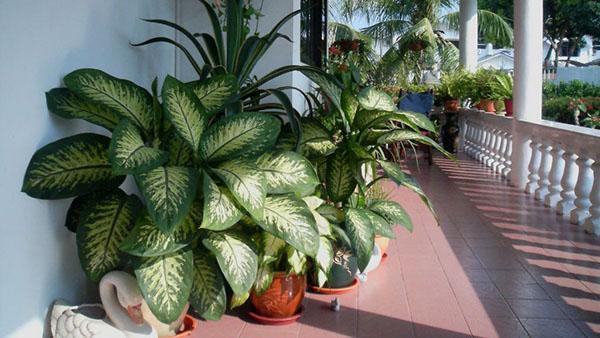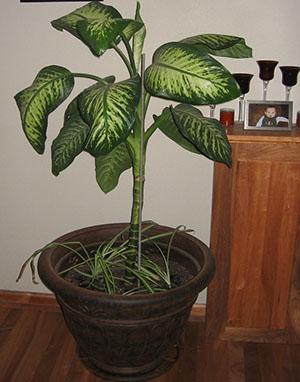Why you can't keep dieffenbachia at home
 Numerous varieties of dieffenbachia have been grown as greenhouse and home crops for more than 150 years, and only in recent years have they increasingly talked about the plant's toxicity.
Numerous varieties of dieffenbachia have been grown as greenhouse and home crops for more than 150 years, and only in recent years have they increasingly talked about the plant's toxicity.
Why is dieffenbachia dangerous, why can't you keep this spectacular plant at home?
The history of the introduction of dieffenbachia into culture

After the discovery of America, during the development of previously unknown lands in Oceania and the Caribbean, plants from new territories often ended up on neighboring islands and the mainland. That is how, with the ships of traders and pirates, Dieffenbachia was brought to the south of the present USA, Tahiti, Hawaii, the Cook Islands and other tropical regions. Then the culture was brought to Europe.
Thanks to powerful shoots, dense juicy foliage and a capricious disposition, soon after the appearance on the shores of the Old World, plants became desirable in greenhouses, and then settled in houses on window sills.
Since then, dieffenbachia has never become the culprit of serious poisoning or death of people. At least, neither the press nor the doctors mentioned that dieffenbachia is poisonous or not.
On the American continent, a picky plant is so well and quickly adapted to new conditions that in many places it has become a real weed. Here, no one thought to keep dieffenbachia in pots, but in the open field it never revealed its harmfulness. Unless it is gradually replacing native species, occupying the best places and lands under the warm sun.
 What is the fault of dieffenbachia, is it possible to keep it at home or is it better to get rid of powerful green pets with beautiful foliage?
What is the fault of dieffenbachia, is it possible to keep it at home or is it better to get rid of powerful green pets with beautiful foliage?
Doubts about the benefits and harms of dieffenbachia appeared in the 20th century, when scientists studied the composition of greens not only of this culture, but also of other representatives of the Aroids.
In all parts of these plants, calcium oxalates were found, which have an irritating effect on the skin and mucous membranes of the eyes, respiratory organs and the digestive tract. In some species, the content of potentially hazardous substances was scanty, in others - many times more.
The benefits and harms of dieffenbachia
So is Dieffenbachia poisonous or not? If we compare this genus of Aroids with other brothers in the family, we can say that the sap of the plant contains a significant amount of a caustic compound. When it enters the esophagus, the greens cause:
- carving;
- burning sensation;
- painful spasms;
- vomiting.
Irritation, cramps and swelling cannot be avoided if dieffenbachia juice gets into the eyes or on sensitive areas of the body. The most affected are those who are prone to allergic reactions and young children.
 But is culture so dangerous in everyday life and can a dieffenbachia flower be kept at home? If you look at it, then harm from a plant is possible only in three cases:
But is culture so dangerous in everyday life and can a dieffenbachia flower be kept at home? If you look at it, then harm from a plant is possible only in three cases:
- with careless care and neglect of safety measures;
- when the greenery of the flower falls into the hands of small children;
- when pets eat the foliage.
When pruning, replanting and other manipulations with dieffenbachia it is reasonable to use gloves.This requirement must be strictly observed in case of hypersensitivity of the skin and the presence of allergies to other plants.
Safety precautions and assistance for dieffenbachia juice poisoning
If, nevertheless, the juice gets on the skin, eyes or oral mucosa, it is important to rinse it off as soon as possible with running water. The effects of toxins begin to be felt literally in seconds, so there is no need to hesitate.
Swallowing the leaves threatens with laryngeal edema and pain shock. These conditions are especially dangerous for children under the age of three and pets who cannot talk about their problem, which means that it is not always possible to provide them with quick help.
 When the greens of dieffenbachia penetrate into the esophagus, it is necessary:
When the greens of dieffenbachia penetrate into the esophagus, it is necessary:
- give the victim plenty of drink in the form of warm water, milk or a weak solution of potassium permanganate;
- to ensure the receipt of a medicinal product with sorbent functions for neutralization and collection of hazardous compounds in the body
- turn to doctors for help.
So that babies and cats or dogs living in the house are not endangered, it is better to place the dieffenbachia pot out of the reach of risk categories.
Based on all that has been said, one conclusion can be drawn. Question: "Is it possible to keep Dieffenbachia, as in the photo, at home?" should be decided individually if the family has:
- people with hypersensitivity to the components of dieffenbachia juice;
- children under 3-4 years old;
- pets, especially cats, which often try to eat potted flowers.
In other cases, dieffenbachia does not pose a danger, and its owner should only follow basic precautions.
Among other things, it is worth remembering that all green plants, including dieffenbachia, actively purify the air and produce oxygen during the day. But at night the situation changes. Without sunlight, all home cultures replenish the atmosphere of the room with carbon dioxide, so it is better not to put large specimens not only in children's rooms and public places, but also in sleeping rooms.